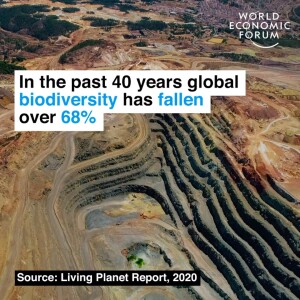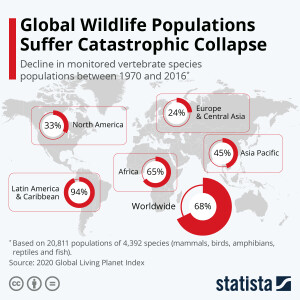The Dramatic Decline of Earth’s Biodiversity
Sep 19th, 2020 | By admin | Category: Biodiversity/ConservationBy Suzanne York.
It feels like a moment of truth for humans and nature. It’s obvious we are in ecological breakdown and need to change course, but will we do it? The weather is becoming increasingly erratic and harsh, from heatwaves in Europe to floods in South Asia. Antarctica’s “doomsday” glacier is breaking. There are epic fires in the western U.S. And rising hunger and poverty rates, combined with racial injustice, is pushing the social fabric closer to a breaking point. Yet business as usual more or less continues, despite our COVID-19 moment that has upended many lives. The stock market goes up, Amazon delivers vast goods, and oil wells churn out barrels and barrels of dirty fuel.Still, the massive wildfires in California, Oregon and elsewhere, along with major storms, have put more people on notice about human impacts on the planet, and that climate change is real. Better late than never, perhaps.
Lest we have any doubts that we are altering life on Earth, two major reports have come out in the past week on the devastating losses to global biodiversity. One is the Living Planet Report 2020, created by WWF and Zoological Society of London; the other is the United Nations’ Global Biodiversity Outlook 5. Both reports acknowledge that the drivers are human population growth, consumption, and habitat destruction. Here is a brief overview of the highlights, or if you prefer, lowlights, of the reports.
Living Planet
The Living Planet Report 2020 tells us again what we already know, that Earth is in trouble and “our relationship with nature is broken.” But its headline-leading statistic is devastating – human actions have resulted in a 68% average decline of birds, amphibians, mammals, fish, and reptiles since 1970.
Below are some of the most startling facts from Living Planet Report 2020:
- To feed and fuel our 21st century lifestyles, we are overusing the Earth’s biocapacity by at least 56%.
- Seventy- five per cent of the Earth’s ice-free land surface has already been significantly altered, most of the oceans are polluted, and more than 85% of the area of wetlands has been lost.
- Almost one in three freshwater species are threatened with extinction.
- Fishing for human consumption is considered to have the greatest impact on ocean biodiversity 2, causing one in three fish stocks assessed to be considered overfished.
- The human enterprise currently demands 1.56 times more than the amount that Earth can regenerate 31. It is like living off 1.56 Earths.
- Only 25% of terrestrial Earth can be considered ‘wilderness’ (i.e. areas having no human footprint score), and that most of this is contained in just a small number of nations – Russia, Canada, Brazil and Australia.
To overcome this reality, the Living Planet report calls for a Bending the Curve Initiative to stem the loss of nature. There are many good solutions in it for stemming the tide of biodiversity loss, such as transforming the food system. There is also a Voices for a Living Planet supplement, which invites “thinkers and practitioners from a range of fields in many countries to share their views on how to bring about a healthy planet for people and nature.” All of these initiatives and ideas need to be implemented now.
Global Biodiversity Outlook 5 (GBO-5)
The Global Biodiversity Outlook 5 (GBO-5), published by the UN Convention on Biological Diversity (CBD), is packaged as an ‘overview on the state of nature.’ This new report called out the global community for missing critical biodiversity conservation targets. None of the 20 targets have been fully met, with only six partially met.
The report calls for a shift away from “business as usual” across a range of human activities and scaling up efforts that will better conserve nature. For those who only care about economics, it’s a smart move to change course. If we continue business as usual, according to the Living Planet Report, it could cost the world economy some $10 trillion by 2050.
As this is a UN report, the Sustainable Development Goals (SDGs) are a major part of the effort to address human impacts on biodiversity. SDGs 3 (Good Health and Well-being) and 4 (Quality Education) cover many issues affecting women and girls, such as access to education and reproductive health. GBO-5 notes that “education, especially for women and girls, has been shown to reduce fertility rates, and, therefore, this goal may have an indirect effect on biodiversity by reducing population growth, a pressure on biodiversity.
It goes on to make this critical but often overlooked point – “Gender roles in many countries have an effect on the use and management of biodiversity by influencing the ability of women to participate in decision-making and by affecting their access to and control of land, biological resources and other productive assets. Greater equality and empowerment of women and girls, as called for in Goal 5, would therefore have a positive effect on biodiversity by affording women greater influence in its use.”
It is encouraging that GBO-5 supports The One Health initiative – “managing ecosystems, including agricultural and urban ecosystems, as well as the use of wildlife, through an integrated approach, to promote healthy ecosystems and healthy people.” All of the pressing issues facing us are connected, and call for measures that operate with this in mind.
What Now?
Much of the focus of GBO-5 is on living in harmony with nature and on transformative actions to get us there. It’s a worthy tome, but its recommendations need to be put place today.
Last year, a report by the Intergovernmental Science-Policy Platform on Biodiversity and Ecosystem Services warned that one million of the nearly 9 million estimated plants and animals could be pushed past the brink in the next few years by human activities. The good news is that we know what to do to halt this dire situation we find ourselves in. The bad news is that we aren’t acting like our house – the planet – is on fire and that we have to act now. Nature is obviously telling us otherwise.
There is much we can do, especially when we proceed with actions that put Nature front and center along with people. We don’t have to recreate the wheel, just think and act in a way that reflects that humanity is part of the web of life. We used to exist that way, not so long ago.
What can we do? Here are some of the best solutions for human and planetary health to alter our catastrophic trajectory:
- Rights of Nature
- Green New Deal
- Indigenous land stewardship
- Set aside land for Nature – see Nature Needs Half, Half Earth, and Wyss Campaign for Nature
- Rights for women and girls
- Reproductive rights for all
- Agroecology
- Traditional ecological knowledge
- Alternative economies/economic measures
- Vertical farming
- Plant-based diets
There are, of course, a many other solutions and ideas out there (see the above-mentioned Voices for a Living Planet). We don’t have to start from scratch. But we need to act like our house on fire.
Elizabeth Maruma Mrema, Executive Secretary of the Convention on Biological Diversity, emphasized this at the release of GBO5, saying the following words everyone on the planet should hear and heed:
Many good things are happening around the world and these should be celebrated and encouraged. Nevertheless, the rate of biodiversity loss is unprecedented in human history and pressures are intensifying. Earth’s living systems as a whole are being compromised. And the more humanity exploits nature in unsustainable ways and undermines its contributions to people, the more we undermine our own well-being, security and prosperity.
____
Suzanne York is Director of Transition Earth.

![[image: UNEP]](http://populationgrowth.org/wp-content/uploads/2020/09/unep-300x168.png)


![[photo: https://commons.wikimedia.org/wiki/File:Harmony_in_nature_(7395814182).jpg]](http://populationgrowth.org/wp-content/uploads/2020/09/butterfly-cc-300x225.jpg)